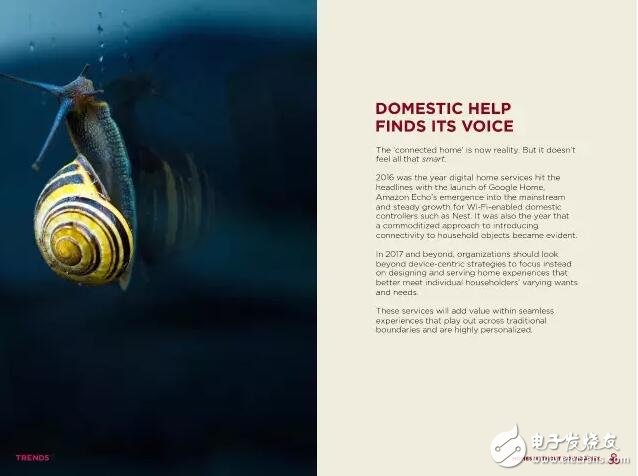Today brings Accenture Fjord's annual report Fjord Trend 2017, which also predicts which technology tipping points will be held in 2017, starting in 5 days. These include autonomous driving, smart homes, chat bots, and mixed reality with AR/VR as part. After a year of accumulation, the report not only gives a prediction of the development trend of the technology, but also analyzes the development points of the technology in the past year. Xinzhiyuan compiled and compiled the full report.
A 12-month study, 1000+ cups of coffee and paper made from trees in a forest (don't worry, we are recycling), which is the price of our 2017 trend report. This report provides an in-depth interpretation of the eight most important technological developments that we believe will affect business design and innovation, government and society in the coming year.
From developing equipment to developing for the environment
In the past 10 years, smartphones have been the absolute core of our digital world. In 2017 and beyond, the focus of the digital world will shift from mobile technology (which is still key now) to the environment we spend, and how to use the best technology to make them more effective.
The way we interact with business will change again
The live-story story and the short, original content are what consumers want to communicate with each other, and what they increasingly want to communicate with the brand. Forget about dazzling billboards, intrusive direct marketing, and repeating TV commercials. The online information platform that disseminates information will be replaced by chat. Relying on technology to drive communication with consumers will become more frequent. However, although the adoption of AI has become more and more popular, human intervention is still needed. In addition, new technologies will create new jobs, whether they are Bot developers, algorithm auditors or consumer consultants.
The balance of trust is swinging
The Oxford Dictionary 2016 vocabulary is "post-truth", reflecting that the current information overload is affecting us all. As simple facts are no longer sufficient to meet the needs of communication and persuasion, individuals, institutions, and brands must build trust by changing their business and communication models, building trust by demonstrating credibility and building emotionally driven relationships. Organizations must extend their horizons beyond consumers and employees to gain social experience.
This is the background of the report. Now let's get straight to the point. In the next report, we looked at eight key trends that we believe will be most important to your organization over the next few months.
table of Contents
1. Short story: Now everyone is the narrator of the story.
2. Reconnect people
3. Mixed reality: beyond AR, VR and MR
4. Self-driving car
5. Borderless families: family assistants find their place
6. Hourglass brand: don't get trapped in the middle
7. I, self and AI
8. Windfall
Xinzhiyuan excerpted the full text of the report and reordered it as follows:
Self-driving car
Self-driving cars, or autonomous vehicles (AVs), will become part of people's daily lives very quickly. Considering the short time available for preparation, each organization should seriously consider how to respond to this trend. Work has been actively carried out, and institutions that respond to change will have huge opportunities. Conversely, those who ignore this trend will be left behind.

Automated vehicles will redefine the automotive industry, and auto companies that are affected by changes in the market environment must face changing business models and the shift in customer expectations.
By 2017, as companies begin to explore a new generation of mobile services, they will turn their attention to cars, seeing autonomous vehicles as a mobile environment connected between multiple devices, and exploring how to integrate the experience between cars and smart homes.
Progress in 2016
In the past year, Google has conducted a high-profile test of its first self-driving car, and Singapore's nuTonomy has launched a driverless taxi service.
Startups are important players in this, with flexibility, vision and cutting-edge technology. For example, London-based autonomous driving company FiveAI announced that it will introduce fully autonomous vehicles to the market by 2019, using more sophisticated machine learning techniques, two years ahead of BMW and Ford.
The US Department of Transportation's National Highway Traffic Authority issued the first federal automated car policy that includes six different levels of self-driving car guides. This level system is developed by the International Society of Automotive Engineers and ranges from no automation (level 0) to full automation (level 5).
Other organizations have also formed new alliances to pave the way for next-generation connectivity and integrated car services. For example, Uber and SpoTIfy work together to allow passengers to personalize their Uber itinerary by remotely controlling music through the SpoTIfy app.
At the end of the year, the Florida Department of Transportation has begun to assess the potential impact of autonomous vehicles on public services and rethink future urban planning.
Future Trends
The car sales market may slow down as the appeal of a car brand itself to consumers will be distracted. The business model of the automotive industry will also change. With the advent of new business models, such as premium car sharing services, BMW's ReachNow may combine the service nature of Airbnb, Car2Go, Uber and ZipCar.
Autonomous vehicles will change the landscape of car services. Autonomous vehicles will prompt people to rethink urban planning as demand for public parking spaces decreases. At the same time, the medical services industry will need to plan for the expected reduction in accidents. Fines imposed by speeding and parking violations will be reduced, and local councils will need to consider new sources of funding for road maintenance.
Autonomous vehicles will also open up new opportunities for other industries. When people no longer need to focus on driving, they will have more time to work, use video chat or use new products and services. The use of in-vehicle mobile Internet will increase dramatically, bringing new revenue opportunities to telecommunications and entertainment companies that offer a new generation of in-vehicle Internet services.
FJORD's advice
1. Don't hesitate to enter the new world.
When the user no longer needs to grip the steering wheel, the relationship between the car and the user will fundamentally change. This situation is likely to be achieved in the 2020s, and any medium- and long-term investments (such as real estate) will be affected. Autonomous vehicles will be the platform for a new generation of digital products, services and user experiences. You need to understand what your business will be able to play in this new car ecosystem.
2. Don't just think about "cars."
The car itself is not an end, and the car is part of an interconnected ecosystem. These connections will create new experiences and service needs that challenge the concept of cars. New patterns of consumer behavior and consumer expectations should be analyzed to identify new opportunities. Determine what experience you want to offer to consumers and then do it.
3. Re-equip and stay flexible.
The carmaker's thinking needs to be more like a researcher, the action needs to be more like a designer, and then the technology is like a software company. There is a need to change from structure, process and design, which in turn will bring a new era of cars.
2. Borderless families
"connected home" has now become a reality. But this concept is not yet particularly smart.
With Google's launch of Google Home, Amazon's Echo has become mainstream, and the steady growth of WiFi-enabled home control devices such as Nest, 2016 is a hot year for digital home services. At the same time, the commercialization of these smart homes has become very clear.

By 2017 and beyond, companies should move beyond the device-centric strategy to design and deliver a home experience that better meets the needs of different individuals and families. These seamless experiences that span traditional boundaries and are highly personalized will increase the value of smart homes.
Progress in 2016
In early 2016, Facebook CEO Zuckerberg announced that he would develop his own artificial intelligence assistant to help him with everything from playing music, identifying visiting friends, to automatically monitoring baby and VR data presentation. At the end of the year, Zuckerberg released personal assistant Jarvis, which realized the rant at the beginning of the year.
However, the automation of today's home connected devices is clearly not enough. An important aspect that smart homes are often overlooked is that these connections change the way people understand and attitude toward “homeâ€.
FJORD's advice
Digital service companies must understand the technology that home users want to have. They need to focus on the valuable experience that existing connectivity can achieve by rethinking their smart home technology and commercial ecosystem by leveraging open APIs, which in turn means that services can exchange data.
If companies want to open up this market and attract average home users (not just technology enthusiasts) to buy their products, companies need to think about the true value of their products.
1. From "smart" to "useful"
“Smart†means not only automation or interconnection, it also means being smart, thoughtful and user-friendly. Therefore, the first thing to consider is their impact on people, their relationship with people, and the preferences and environment of users to determine the best and most effective way.
2. Beyond the family, to a larger physical space.
Today's smart homes also over-emphasize the connectivity of objects and lack the use of connectivity to create valuable home experiences. Home automation sounds interesting, but in reality people don't really care. Our services need to consider users, not devices.
3. Design for the user, not the device.
Technology is extending beyond its traditional physical limitations to extend safety, comfort and personal preferences beyond the home. Companies should see this trend and look for ways to expand the benefits they can offer.
With 15+ years manufacturing experience for phone accessories.
Supply various portable charger for iPhone, Airpods, laptop, radio-controlled aircraft ,laptop, car, medical device, mobile device, ect.
Avoiding your devices run out of charge, Portable Chargers to keep your mobile device going.
From the original ordinary power bank charger to wireless power bank, green energy solar power bank, magnetic mobile power, Portable Power Stations and other products continue to innovate.
We help 200+ customers create a custom mobile power banks design for various industries.
Portable Charger,Power Bank Charger,Mini Power Bank,Wireless Power Bank, Solar Power Bank
TOPNOTCH INTERNATIONAL GROUP LIMITED , https://www.mic11.com
![<?echo $_SERVER['SERVER_NAME'];?>](/template/twentyseventeen/skin/images/header.jpg)